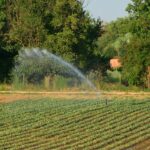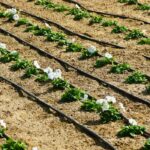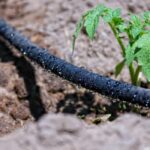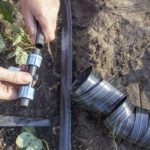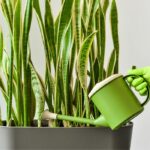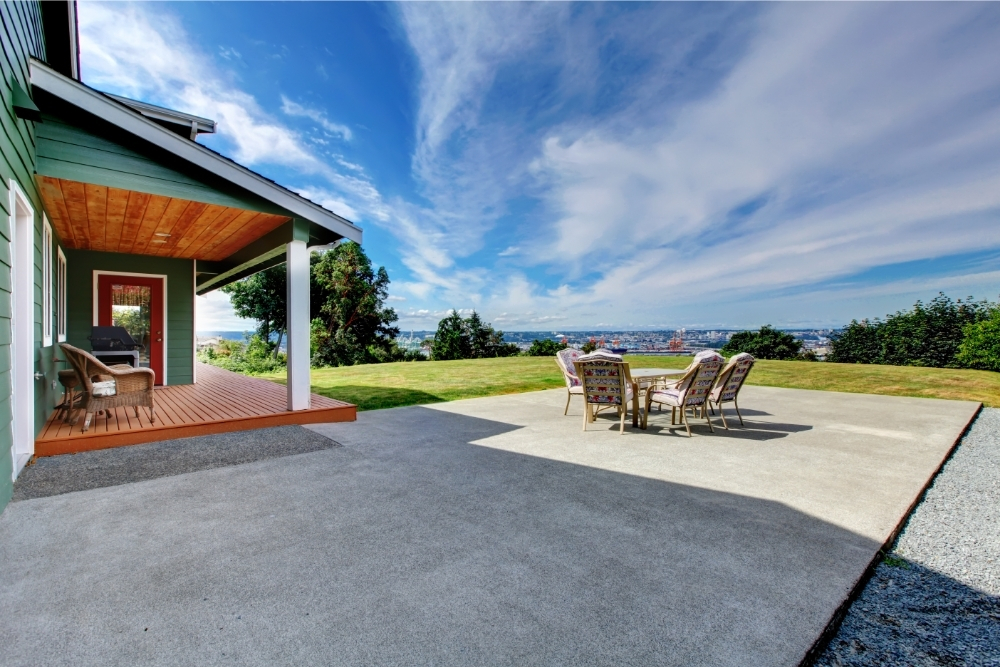A properly installed irrigation system is essential to keeping your plants hydrated, beautiful, and healthy. There are two primary types of irrigation systems: drip irrigation and sprinkler systems. But before you pick the one for your garden or yard, you’ll need to consider a range of factors, including costs. So, which system is more expensive?
A drip irrigation system is typically more expensive than a sprinkler system. The installation cost of a sprinkler system can be up to $2.50 per foot, while a drip irrigation system costs up to $4.50 per foot. However, drip irrigation runs on low pressure, which means reduced energy and water costs.
Both drip irrigation and sprinkler systems are effective irrigation methods that comes with own advantages and disadvantages. Choosing the one that’s best for you depends on the size of your garden and the type of plants you’re growing. Let’s look at the installation cost of both systems as well as some other factors to find out which system will work for you.
Are Drip Irrigation Systems More Expensive Than Sprinklers?

Before deciding on a drip irrigation or sprinkler system, it’s essential to compare the cost of their initial installation as well as the long-term costs.
The per square foot installation cost of a sprinkler system typically ranges from $1.50 to $2.50, depending on the layout and size of your property.
Although sprinklers are cheaper compared to drip irrigation systems, they usually require extra planning and setup. The additional labor cost can jack up the price of this system.
Drip irrigation systems, on the other hand, are more expensive on paper. They typically cost between $2.50 and $4.50 per square foot. However, in the long run, this system may prove to be more economical due to reduced water bills.
Before choosing a particular system, let’s look at how each system works and their advantages and disadvantages.
Drip Irrigation Systems

A drip irrigation system like this one (on Amazon) delivers water directly to the root zone of the plants. It’s tubes are designed with tiny holes located at regular intervals that enable water to seep into the soil near the plant roots where it’s most needed.
This system can be placed under the soil or above the ground and can be customized completely to fulfill specific watering needs.
Benefits of Drip Irrigation
There are several benefits of drip irrigation. These include:
Minimum Water Wastage
In a drip irrigation system, there’s very little water wastage. Since water is applied directly to the plants, there’s hardly any evaporation, and water isn’t wasted on the parts of the lawn that don’t need it. This results in maximized water conservation and reduced labor and water costs.
Eliminates Weeds
Because water is supplied directly to the plant roots, there’s hardly any water left over for weeds to thrive. This makes it easier to care for your yard.
Suitable for Irregularly-Shaped Gardens
To install the drip irrigation system, it’s not necessary to level the ground. You can easily lay drip tubes in yards and gardens that are irregularly shaped.
Minimum Soil Erosion
The slow watering of the plants that occurs with drip irrigation allows the soil more time to absorb the maximum amount of water, which results in less runoff and deeper waterings. Utilizing this slow watering technique also minimizes nutrient leaching and soil erosion problems.
Doesn’t Interrupt Your Gardening Routine
A sprinkler system can cause your soil to become muddy, which can make it difficult to work in your garden. Nobody likes to get down in the mud just to get some weeding done.
This often means that while using the sprinkler system, you’ll need to stop working in your garden until the moisture in the soil evaporates. With a drip irrigation system, you can work among your plants even while they’re being watered.
Boosts Plant Health
As the water in drip irrigation seeps gradually below the surface of the soil, it allows plants to develop a healthy and strong root system. As a result, your plants will be healthier, and you’ll be able to enjoy better yields.
Minimizes the Risk of Diseases
A wet garden environment can pave the way for many common and dangerous plant diseases. Mildews, rot, and fungal diseases tend to spread faster in wet weather. A drip irrigation system supplies water only to the plant roots, keeping the foliage dry. This prevents plant diseases that can typically develop on wet leaves.
Uniform Water Application
As the plants grow bigger and develop denser foliage, it can become difficult for a sprinkler system to ensure that water reaches the soil around the plant roots. This is not a problem with drip irrigation.
As water is applied directly to the roots, there are no obstacles between the plants and water. You can also control the output and placement of each emitter to ensure that each plant gets the amount of water it needs.
Saves Energy Costs
The drip irrigation system is operated at lower pressures compared to other types of pressurized irrigation. This reduces energy costs and helps you save money over time.
Drawbacks of Drip Irrigation
Although a drip irrigation system is highly suitable for certain environments, it also has some drawbacks that need to be considered. These drawbacks include:
Needs Time and Investment
Although in many cases a drip irrigation system is considered more effective than other irrigation methods, the initial start-up cost of this system is quite high. The setting up of this system is time-consuming as well.
As you add more plants or the plants get bigger, you’ll need to add tubings and emitters (on Amazon) to fulfill the watering needs of the plants. This system also requires regular maintenance, which means that you’ll have to devote both your time and energy to ensure efficient performance.
Tends to Get Clogged
Algae, debris, and mineral buildup present in the water supply can clog emitters that deliver water to the plants. That’s why it’s essential to carefully inspect your drip irrigation system regularly.
Flush the irrigation tubes periodically to keep the water flowing freely. Adding a filter to your system can also help prevent issues typically associated with poor water quality.
Not Suitable for Watering Grass
Drip systems aren’t suitable to cover large areas of plant life efficiently. They aren’t the best option when it comes to watering grass and large areas of flowers.
Can Be Easily Damaged
The above-ground drip system is prone to getting damaged from exposure to UV rays and movement. The drip tubing can be chewed by rodents and can also be a tripping hazard.
Sprinkler Systems
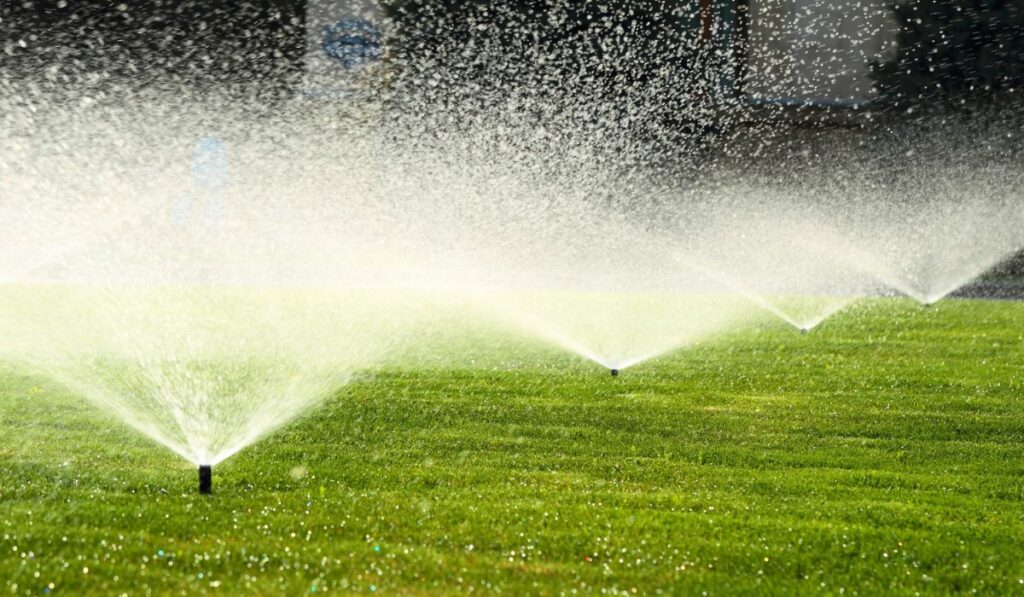
Sprinklers have been used to water grass for many years. These systems typically consist of sprinkler heads (on Amazon) that are buried at specific locations to spread water over a large area. A sprinkler system is customized for each lawn to provide optimal water coverage. By automating your sprinkler system, you can enjoy greater convenience.
Benefits of Sprinklers
A sprinkler system is often the best way to deliver water across a large area. The benefits of this system include:
Convenience
Not many people find the chore of manually watering their garden several times a week a pleasant one. This is where sprinklers come in. Many homeowners find the ability to automate the watering frequency and schedule to be among the best features of sprinkler systems.
An automated irrigation system means that you don’t have to worry about watering the lawn, and you can easily spend time away from home without worrying about the plants.
Suitable for Large Grounds
The best thing about sprinklers is that one sprinkler can cover a lot of ground. A big rotary or Rain Bird sprinkler (on Amazon) can water large areas of a garden. In case you have a small garden, only one sprinkler may be enough.
Automated Watering of Your Lawn
You can schedule your sprinkler system to provide water to your garden during optimal times of the day. In addition, you can set the exact amount of water, depending on the type of plants and grass being irrigated.
According to experts, the optimal time to water your garden is before full sunlight occurs. Watering your lawn after sunset, meanwhile, increases the risk of fungus and diseases because the garden remains moist overnight.
Using moisture and rain sensors, you can program your sprinkler system to deliver the correct amount of water to each zone of your garden. Overwatering or under-watering your lawn can have a negative effect on your plants and grass. With a sprinkler system, you can automate and control the watering of your lawn, which makes this system very beneficial.
Reduced Costs
The optimal time to irrigate your yard is during the early morning hours. By programming your sprinkler system to water your lawn at the optimal time, you can ensure less water wastage due to evaporation.
Variety of Sprinkler Heads
You can choose from a wide range of sprinkler heads and hoses to make sure that your plants get the exact amount of water they need. A properly timed and automated irrigation system together with well-matched hoses and sprinkler heads according to the plant zone is an excellent way to reduce overall utility costs and water usage.
Enhanced Resale Value
A sprinkler system ensures a beautiful and healthy garden appearance, which helps enhance the curb appeal of your property. A well-cared-for yard creates a favorable impression on potential buyers when they come to view your home. Your garden may just be the thing to sway potential buyers.
Drawbacks of Sprinklers
Sprinkler systems have the following disadvantages:
Loss of Water
Although a sprinkler system is more efficient compared to watering your lawn manually with a hose, there’s still quite a lot of water wastage if the system isn’t adjusted properly. In addition, sun and wind can cause water to evaporate before it reaches the soil.
Sprinklers typically have a shallow soil effect, which means the water may not actually reach the roots of the plants.
Increased Number of Mosquitoes and Weeds
When your lawn is watered by a sprinkler system, large puddles of water may appear between the plant rows, providing favorable conditions for the growth of weeds and mosquitoes.
Regular Maintenance and Repairs
In addition to installation costs, it’s essential to keep the repair and maintenance costs of the irrigation system in mind. There are quite a few moving parts in sprinklers that may need replacement or adjustment periodically.
Sprinkler heads can become misaligned and may require manual adjustment. Routine yard maintenance like mowing can also damage the sprinkler heads, and you might need to replace them completely.
The underground sections of the sprinkler system can be damaged by intrusive plant roots and pests. This may mean costly repairs in the case that sections of your yard need to be dug up to access and repair damaged pipes.
Wet Leaves Are Susceptible to Diseases
Sprinklers don’t only provide water to the roots but to the leaves of plants as well. This can be a problem since many diseases are caused due to the moist foliage of garden plants.

